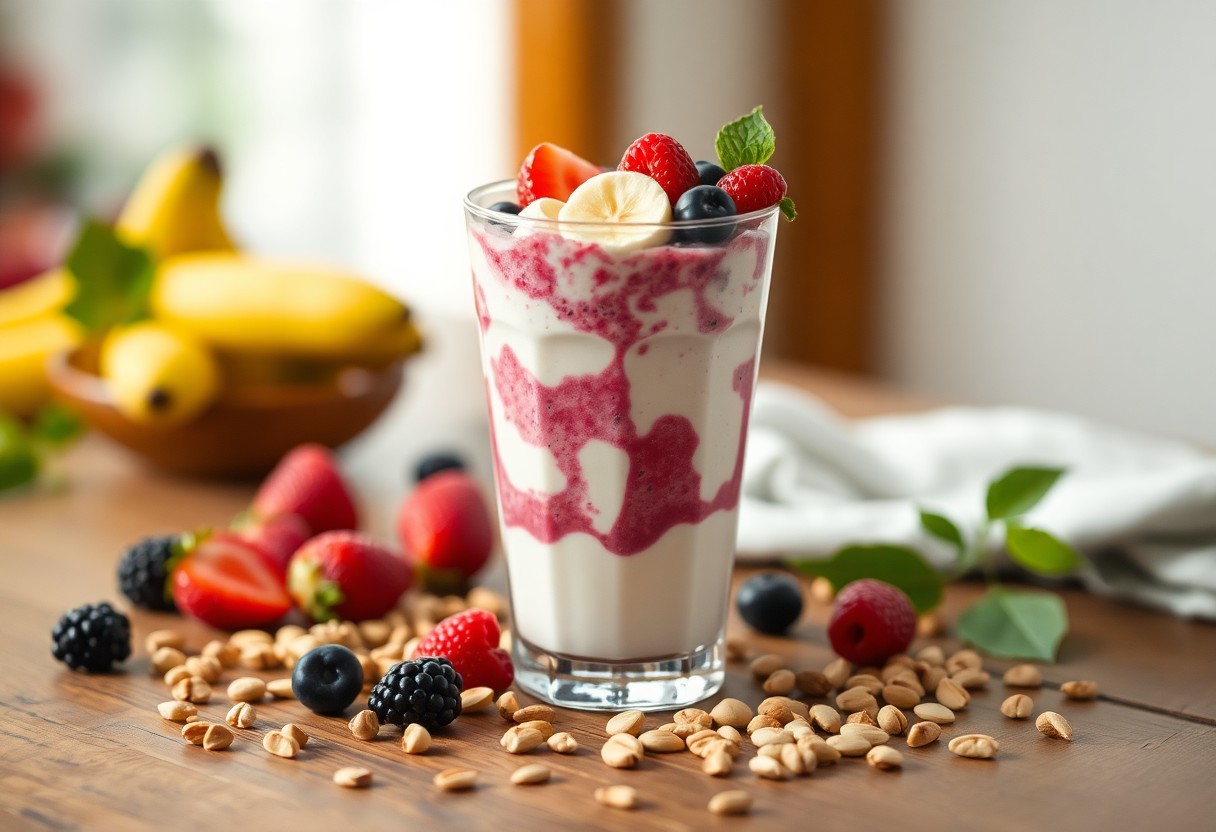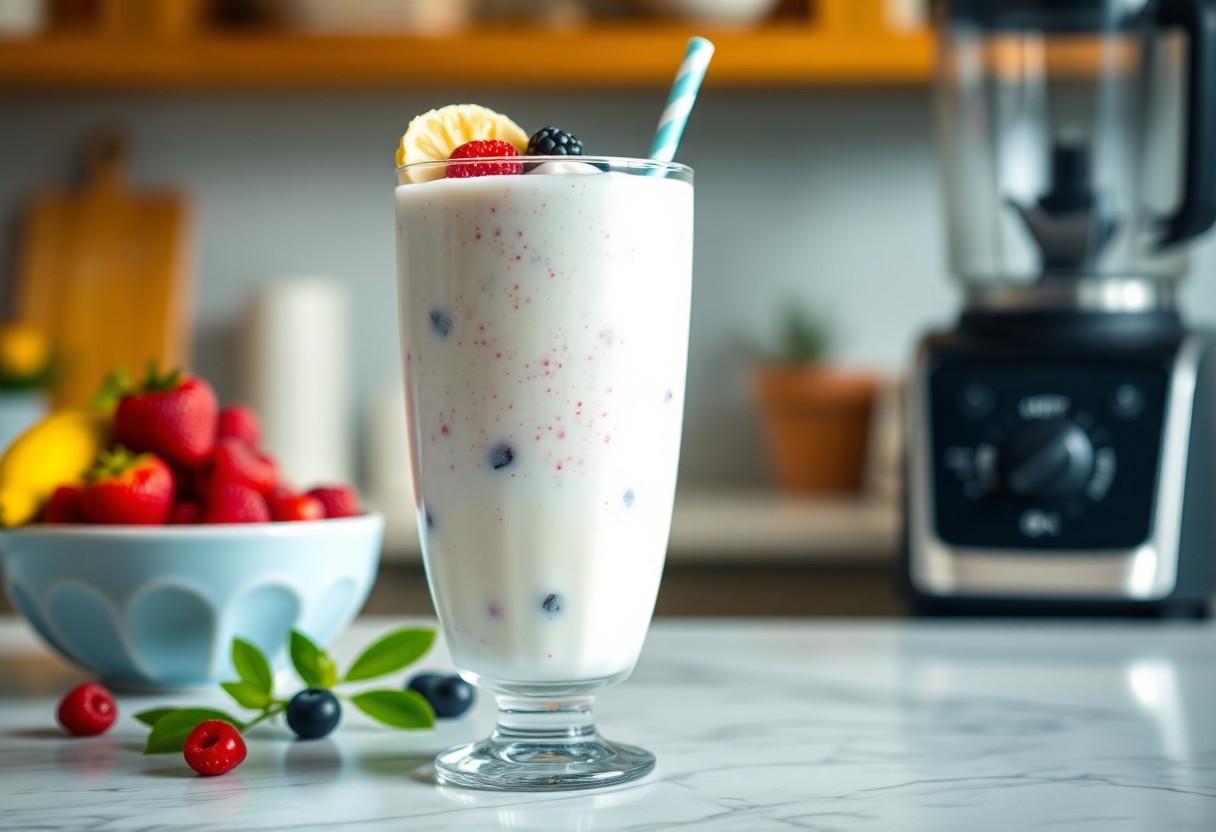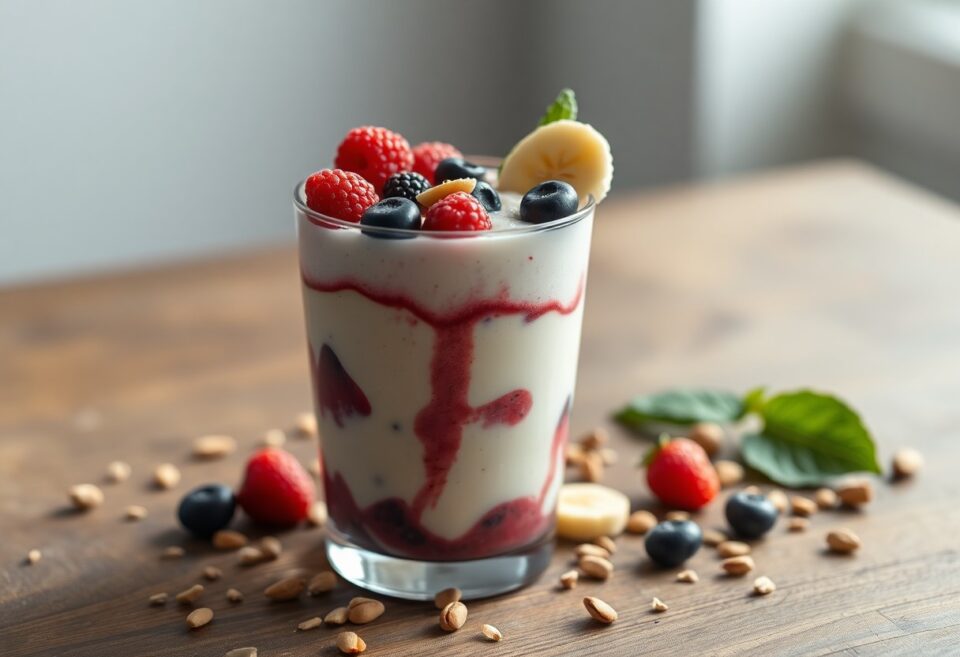There’s a simple way to boost your daily protein intake without sacrificing flavor or convenience—Greek yogurt smoothies. By incorporating Greek yogurt into your smoothies, you provide your body with a rich source of protein that supports muscle repair and keeps you feeling full longer. You can easily customize these recipes with fruits, nuts, and seeds to match your taste and nutritional goals. With these recipes, you’ll enjoy an efficient and delicious protein fix that fits perfectly into your busy lifestyle.
The Protein Powerhouse: Why Greek Yogurt is a Game Changer
Nutritional Benefits of Greek Yogurt
Greek yogurt stands out as a nutritional titan among dairy products, primarily due to its impressive protein content. Unlike regular yogurt, Greek yogurt undergoes straining to remove excess whey, concentrating its protein density. You can find approximately 15-20 grams of protein per 6-ounce serving, which is about double the amount in traditional yogurt. This high protein content not only fuels muscle repair and growth but also helps sustain your energy levels throughout the day. Additionally, the texture of Greek yogurt is thicker and creamier, making it an excellent base for smoothies that blend both flavor and nutrition seamlessly.
Beyond protein, Greek yogurt offers a rich source of crucial micronutrients. It supplies a hefty dose of calcium, delivering up to 18% of your daily value in a single serving, which supports bone health and muscle function. Greek yogurt also provides beneficial probiotics that foster a healthy gut microbiome, aiding digestion and immune health. Moreover, it contains less sugar compared to many flavored yogurts on the market, making it a smart choice if you’re watching your sugar intake. Incorporating it into your smoothies ensures that you’re not just getting a protein fix but also reaping benefits related to your overall well-being.
The versatility of Greek yogurt stretches beyond its nutrients—it also adapts to different dietary needs. Since it typically contains less lactose than regular yogurt due to the straining process, people with mild lactose intolerance often find it easier to digest. For those who follow low-carb or ketogenic diets, Greek yogurt serves as a low carbohydrate snack option while still packing in high protein. This universal appeal has led to its rapid rise as a staple in kitchens, particularly for fitness enthusiasts and health-conscious individuals who demand both nutrition and convenience in their meals.
The Role of Protein in a Balanced Diet
Protein acts as the building block for nearly every cell in your body, playing a vital role in maintaining muscle mass, repairing tissues, and supporting immune function. Its inclusion in your daily meals is indispensable for keeping these processes running efficiently. When you consume adequate protein, you help facilitate muscle protein synthesis, which is especially valuable after exercise or periods of physical stress. Greek yogurt’s protein content makes it an excellent choice to repair and recover muscles, promoting lean muscle development and aiding in the prevention of muscle loss as you age.
Beyond muscle health, protein has a pronounced effect on satiety and weight management. Eating protein-rich foods like Greek yogurt slows digestion and enhances feelings of fullness, which can naturally reduce your calorie intake over time. Research has shown that diets higher in protein help regulate appetite hormones such as ghrelin and peptide YY, reducing hunger pangs between meals. Incorporating Greek yogurt smoothies into your diet is a smart strategy for managing cravings and staying on track with weight goals without sacrificing nutrient density.
In addition to these benefits, protein plays an influential role in metabolic health and hormone regulation. Balanced protein intake helps stabilize blood sugar levels by slowing carbohydrate absorption, reducing the risk of insulin spikes. This effect is beneficial for managing metabolic conditions such as type 2 diabetes and supporting overall cardiovascular health. Including Greek yogurt as a protein source integrates seamlessly into a balanced diet, enabling you to control energy fluctuations and support long-term health.
Further expanding on protein’s impact, explain how protein turnover—the cycle of protein synthesis and breakdown—keeps your body functioning optimally. With each meal rich in high-quality protein, like Greek yogurt, you supply your body with crucial amino acids that your cells use to replace damaged proteins rapidly. This dynamic balance is crucial not only for muscle health but for maintaining skin, hair, enzymes, and hormone production. Hence, by embedding Greek yogurt smoothies into your routine, you actively support these regenerative processes every day.
Smoothie Fundamentals: Crafting the Perfect Blend
The foundation of your perfect Greek yogurt smoothie lies in understanding how different ingredients interact and which combinations deliver both the best taste and nutritional profile. Your choice of Greek yogurt as a base already sets you up with a dense protein source, but it also adds a creamy texture and tartness that balances sweetness and other flavors. Integrating other components like fresh or frozen fruits, vegetables, liquids, and superfoods allows you to customize the nutrient content and flavor depth. For example, blending Greek yogurt with berries not only enhances antioxidants but also introduces natural sweetness without excess sugars.
Achieving a balanced smoothie also means paying attention to portion size and nutritional density. With protein as a priority, you want to avoid diluting the concentration of protein per serving by loading your blend with too many low-protein fillers. You can optimize muscle repair and satiety by including complementary protein-rich ingredients like nut butters or protein powders, while the yogurt helps maintain a smooth texture that doesn’t feel gritty or too thick. As you experiment, you might find a successful ratio is roughly one cup of Greek yogurt paired with 1-2 cups of fruits or veggies, which maintains the ideal nutritional balance.
Successfully crafting your smoothie involves more than just throwing ingredients into a blender. The order of addition, blending time, and breaking down frozen items into manageable pieces can dramatically influence the consistency and flavor release. You could begin by pulsing frozen fruits to avoid overworking your blender before adding the yogurt and liquids. This technique prevents a runny, watery final texture and preserves the hearty essence of the protein base. Once you master these fundamentals, you’ll find your smoothies not only satisfy your protein needs but also delight your palate and keep you energized.
Essential Ingredients for a Protein-Rich Smoothie
Starting with Greek yogurt gives you an impressive 10 to 20 grams of protein per serving, which can vary depending on the brand and whether you choose non-fat, low-fat, or full-fat varieties. Pairing this with additional protein sources creates a powerhouse blend. For example, adding a tablespoon of chia seeds contributes about 2 grams of protein while also offering omega-3 fatty acids and fibers that support digestion. Likewise, a scoop of plant-based or whey protein powder can easily boost your protein content by 20 grams or more, helping you reach your daily goals effortlessly.
Complement these primary proteins with ingredients that provide both nutrition and enhance the texture. Nut butters like almond or peanut butter add healthy fats, flavor, and a modest protein bump—around 3 to 4 grams per tablespoon—while keeping your smoothie rich and creamy. Silken tofu is another versatile option, quietly ramping up protein and contributing to an ultra-smooth texture for those seeking a plant-based or dairy-free alternative. This also gives you the flexibility to tailor the smoothie’s taste and mouthfeel without sacrificing protein content.
Liquid choices also affect protein concentration and absorption. Cow’s milk naturally contains about 8 grams of protein per cup, whereas fortified plant milks may have less unless enriched. Using milk as the liquid base reinforces your smoothie’s dairy protein content, while coconut water or fruit juices focus more on hydration and flavor than protein. The balance here influences your drink’s purpose—whether it’s for muscle repair, energy provision, or a refreshing snack. Assume that picking the right protein sources and liquids aligns closely with your fitness and nutrition goals to make every smoothie count.
Tips for Achieving the Right Consistency
Consistency can make or break your smoothie experience, especially when Greek yogurt is involved. You want a blend that is neither too thin nor overly thick, striking a hearty yet drinkable texture. Frozen fruits are your best friend here, lending a natural chill and thickness without watering down the flavor. For a standard single-serving smoothie, aim for roughly one cup of frozen fruit along with a cup of Greek yogurt; this ratio forms a luscious base, allowing you to add liquid gradually to fine-tune texture.
Controlling moisture levels is one of the simplest ways to fine-tune consistency. Excess liquid from ingredients like fresh fruit or too much milk can turn your smoothie runny, reducing its satisfaction factor. You can balance this by incorporating thickening agents like oats, chia seeds, or even a small scoop of avocado, which enrich the texture while keeping it cohesive. Especially when blending large batches, adding these components ensures you maintain the rich, smooth mouthfeel throughout multiple servings.
The sequence in which you add ingredients also impacts consistency. Adding heavier elements like Greek yogurt and nut butters first gives your blender a solid base to break down harder or frozen ingredients efficiently. Following with liquid helps lubricate the blades and encourages smoother blending. Blend in short bursts to preserve airiness or longer if you prefer a denser texture. Small adjustments to blending time can elevate the overall smoothness and avoid graininess associated with over-blended seeds or fibrous veggies.
Diving deeper into managing your smoothie’s consistency, consider these techniques:
- Frozen vs. fresh fruits: Frozen fruits thicken the texture without requiring ice, preventing excess water dilution.
- Gradual liquid addition: Pour liquids slowly to avoid overshooting desired thickness and allow better control.
- Using thickeners like oats or chia seeds: These ingredients absorb moisture and add body but also enhance nutritional value.
- Blender speed and duration: Pulsing softer ingredients then blending harder ones at high speed ensures a creamy result.
- Layering ingredients: Add thick components first and liquids last for optimal blade movement.
Assume that mastering these consistency strategies enables you to tailor every Greek yogurt smoothie precisely to your taste and texture preferences, creating a delightful, protein-packed treat every time.

Flavor Innovations: Unconventional Additions to Your Smoothie
Fruits and Vegetables: Beyond the Basics
Exploring beyond the typical strawberry-and-banana combo can transform your Greek yogurt smoothie into a vibrant, nutrient-dense experience. Adding lesser-known fruits like dragon fruit or persimmons provides a visually stunning and antioxidant-rich punch that naturally elevates the health quotient of your drink. For example, dragon fruit contributes not only a vivid magenta color but also betalains, a powerful antioxidant class known to reduce inflammation and improve cholesterol levels. Meanwhile, persimmons offer an impressive dose of vitamin A and a unique sweetness that complements the tangy tang of Greek yogurt.
Integrating vegetables may sound unconventional, but it opens an entirely new spectrum of flavors and health benefits. Consider adding lightly steamed and cooled beets, which introduce natural sugars with earthy undertones alongside dietary nitrates that support blood flow and stamina. Spinach and kale remain popular, but you could also experiment with watercress or Swiss chard to produce more nuanced, slightly peppery tastes. These greens carry a significant amount of vitamin K—important for bone health—which is often overlooked in fruit-heavy smoothies.
Texture can also be amped up smartly with vegetables like cucumbers or celery for hydrating, low-calorie crunch embedded within your creamy blend. You might even try adding frozen cauliflower florets; when pureed, they’re virtually undetectable and remarkably increase fiber content without diluting the flavor. Interlacing these unconventional ingredients shifts your smoothie from a quick snack into a meal-packed power option that satisfies both palate and performance goals.
Spices and Superfoods that Boost Nutrition
Your Greek yogurt smoothie can benefit immensely from the integration of select spices and superfoods that offer both depth of flavor and substantial health advantages. Turmeric, with its active compound curcumin, is a standout; it fights oxidative stress and inflammation while imparting a warming hue and subtle pepperiness. To enhance turmeric’s bioavailability, pairing it with a pinch of black pepper within your smoothie is scientifically supported and markedly effective.
Cinnamon is another versatile spice that not only imparts a sweet, woody aroma but also assists in improving insulin sensitivity, which can be particularly advantageous if you use smoothies to regulate energy levels throughout the day. Adding a teaspoon of cinnamon powder can transform a simple berry blend into a complex flavor profile that supports balanced blood sugar, according to numerous clinical trials. Beyond these, adaptogenic herbs like ashwagandha or maca powder provide stress-relieving and energy-boosting properties that coincide perfectly with your fitness and wellness objectives.
Superfoods like chia seeds, hemp hearts, or spirulina enhance the protein, omega-3 fatty acid, and micronutrient content dramatically. Chia seeds swell in liquid, adding thickness while releasing fiber that improves digestion and satiety. Spirulina’s deep green pigment signals its bounty of amino acids, B vitamins, and antioxidants, contributing to both the smoothie’s nutritional robustness and vibrant look.
Incorporating these spices and superfoods into your Greek yogurt blends is more than a trend—each addition has a grounded basis in nutritional science and traditional medicine. Their synergistic effects amplify anti-inflammatory, antioxidative, and adaptogenic benefits that conveniently complement the protein-rich base you’re already enjoying. This thoughtful layering of ingredients helps you achieve not only flavorful variety but also meaningful health gains in every sip.

Trendy Recipes to Try: Easy Greek Yogurt Smoothies
Classic Favorites: Tried-and-True Recipes
You can never go wrong with classic Greek yogurt smoothies that have stood the test of time. One such recipe is the traditional strawberry-banana blend. Combining ripe, juicy strawberries with a perfectly sweet banana and thick Greek yogurt delivers a creamy texture packed with natural sweetness. The tang of the yogurt complements the fruits beautifully, offering a smoothie rich in protein and antioxidants. This recipe typically calls for about one cup of Greek yogurt paired with one cup of mixed fresh or frozen berries, making it convenient and straightforward to prepare.
Another timeless option involves mixing Greek yogurt with blueberries and a hint of honey. Blueberries are renowned for their high vitamin C content and antioxidant properties, which synergize well with the probiotic benefits of Greek yogurt. By adding just a teaspoon of honey, you introduce a subtle floral sweetness, perfectly balancing the tartness. The result is a smoothie you can whip up in under five minutes with simple ingredients right from your pantry or freezer.
For those who enjoy a nutty dimension, the peanut butter and Greek yogurt smoothie remains a staple. Incorporating a tablespoon or two of natural peanut butter introduces healthy fats and additional protein, enhancing satiety. The creamy texture remains intact, and a small splash of almond milk can adjust thickness to your preference. This recipe not only energizes you but also satisfies cravings for rich, indulgent flavors without compromising nutritional value.
Seasonal Specials: Incorporating Fresh Produce
As the seasons change, your smoothie ingredients can evolve to highlight the freshest available produce, turning simple Greek yogurt blends into vibrant, nutrient-dense treats. Spring offers the perfect opportunity to add fresh asparagus greens or tender pea shoots along with strawberries and mint, imparting a refreshing herbal twist. These additions provide a potent dose of vitamins A and K while keeping the smoothie light and invigorating. Using seasonal ingredients like rhubarb in early spring or honeydew melon in late summer can elevate flavor complexity and enhance health benefits.
Summer’s bounty opens doors to a variety of stone fruits like peaches, cherries, and plums that blend seamlessly with Greek yogurt. Adding these fruits provides natural sweetness and introduces a wealth of antioxidants, including anthocyanins found in cherries. A splash of freshly squeezed lime juice can brighten the flavor while adding a vitamin C boost. You can also enrich your smoothies with fresh herbs like basil or cilantro, offering a punch of freshness unmatched by frozen or out-of-season alternatives.
Moving into autumn, you can infuse your smoothies with pumpkin puree or roasted sweet potatoes alongside cinnamon and nutmeg. These ingredients not only bring warmth and a creamy texture but also pack beta-carotene and fiber. Combining these fall flavors with Greek yogurt creates a nostalgic yet healthy snack, perfect for cooler days. Additionally, incorporating fresh cranberries, either whole or juiced, introduces tartness and antioxidants, enhancing both flavor profile and immune support.
Exploring the use of seasonal produce in your Greek yogurt smoothies allows you to fully capitalize on peak freshness and nutritional content. As fruits and vegetables vary in nutrient density throughout the year, tailoring your smoothies to the season ensures you receive maximum vitamins, minerals, and antioxidants. This approach not only diversifies your flavor experience but also supports local agriculture and reduces environmental impact.

Beyond Smoothies: Other Protein-Packed Greek Yogurt Ideas
Combining Greek Yogurt with Breakfast Foods
Dive into breakfast options by pairing Greek yogurt with your morning staples to give them a protein boost. Mixing it with your oatmeal can transform a simple carb-heavy meal into a balanced dish with ample protein, especially when you stir in a half-cup of Greek yogurt, which adds about 10 to 12 grams of protein. You can top this combo with nuts, seeds, or fresh fruit, creating layers of texture and flavor that also enhance the meal’s nutritional profile. By replacing milk or cream with Greek yogurt, the creamy consistency is maintained without unnecessary fats, making your breakfast both rich and heart-healthy.
Another delicious way to amplify your morning meal is to use Greek yogurt as a base for homemade parfaits. Layering yogurt with granola and berries in a glass not only looks appealing but delivers complex carbohydrates, fiber, and antioxidants alongside protein. Some studies have indicated that this combination can curb hunger and stabilize blood sugar levels, helping you avoid mid-morning energy crashes. For variety, you can swap granola for seeds or nuts, which diversify nutrient profiles while keeping calories in check.
Egg dishes also benefit from a Greek yogurt twist. Adding yogurt into scrambled eggs or omelets can increase creaminess and moisture without extra oil or butter. Plus, integrating a spoonful into egg mixtures bumps up the protein content, catering to muscle repair especially after morning workouts. From a culinary perspective, yogurt also imparts a subtle tang, which complements savory ingredients like spinach, feta, and herbs—giving your breakfast a gourmet edge that’s easy to prepare and satisfying.
Creative Snacks and Desserts Featuring Greek Yogurt
Snacking becomes filling and healthy when Greek yogurt steps into the spotlight. Whipped yogurt can be transformed into a dip for fresh vegetables or whole-grain crackers, infused with herbs, garlic, or spices for a savory twist. This type of snack serves as a great alternative to processed options that tend to be low in nutrients and high in empty calories. Swapping store-bought dips for your own Greek yogurt creation ensures you know every ingredient, helping you control sugar and sodium intake without sacrificing flavor or satisfaction.
On the sweeter side, Greek yogurt can replace higher-calorie ingredients in desserts, making indulgence compatible with a nutritious lifestyle. For example, mixing it with cocoa powder and a touch of natural sweetener creates a rich chocolate pudding that supplies about 15 grams of protein per serving. You can also find recipes where Greek yogurt becomes the star in frozen treats like yogurt popsicles or used as a creamy topping on fruit crisps, providing a refreshing yet protein-rich contrast. These desserts highlight how you can manage cravings smartly, avoiding sugar spikes and excessive fat.
Baking with Greek yogurt opens up another avenue for incorporating protein without changing flavors dramatically. Swapping some of the butter or oil in muffin or pancake recipes with Greek yogurt adds moisture and tenderness while increasing protein content. Trials show that this substitution can reduce overall fat by up to 30% and calories by nearly 20% depending on the recipe, contributing to a healthier eating pattern. Beyond nutrition, this method preserves the texture and taste you want in your baked goods, making it possible to enjoy classic recipes with improved nutritional value.
These versatile snack and dessert ideas illustrate how Greek yogurt comfortably moves beyond conventional use, offering innovative ways to enjoy your favorite foods while maintaining a protein focus. Whether it’s a crunchy snack with a creamy dip or a luscious, guilt-free dessert, the options are abundant and adaptable.
Final Words
From above, you have explored a variety of Greek yogurt smoothie recipes that offer an easy and convenient way for you to increase your protein intake. Incorporating these smoothies into your daily routine can significantly support your health goals, whether you aim to build muscle, lose weight, or simply maintain balanced nutrition. Greek yogurt provides a rich source of protein, probiotics, and necessary nutrients that contribute to overall wellness, making it a powerful base for your smoothies.
You will find that these smoothie recipes are not only nutritious but also versatile and adaptable to your taste preferences and dietary needs. Whether you prefer fruity blends, green-packed options, or indulgent combinations, you can customize each recipe to suit your lifestyle. By making these smoothies at home, you retain control over the ingredients, ensuring you avoid unnecessary sugars or additives often found in store-bought alternatives.
Embracing Greek yogurt smoothies as a protein fix is a smart strategy to fuel your day efficiently and deliciously. You can prepare them quickly in the morning, enjoy them as a post-workout replenishment, or even use them as a wholesome snack between meals. With a little experimentation, you will discover your favorite combinations, making healthy eating both enjoyable and sustainable. Ultimately, this approach empowers you to meet your nutritional needs effortlessly, supporting your journey toward better health.
FAQ
Q: What are the benefits of using Greek yogurt in smoothies?
A: Greek yogurt is an excellent ingredient for smoothies because it is rich in protein, which helps support muscle repair and growth. It also adds creaminess without excessive fat, provides probiotics for digestive health, and contributes vital nutrients like calcium and potassium.
Q: Can I use flavored Greek yogurt for my smoothie recipes?
A: Yes, flavored Greek yogurt can be used to add extra taste and sweetness. However, be mindful of the added sugars in flavored varieties. If you prefer to control sweetness and nutritional content more precisely, plain Greek yogurt combined with fresh or frozen fruits is a great option.
Q: What fruits pair well with Greek yogurt in smoothies?
A: Many fruits complement Greek yogurt well, including berries (strawberries, blueberries, raspberries), bananas, mango, peaches, and pineapple. These fruits add natural sweetness, vitamins, and antioxidants to your smoothies while balancing the tangy flavor of the yogurt.
Q: How can I make a Greek yogurt smoothie thicker or thinner?
A: To thicken your smoothie, add frozen fruits, more Greek yogurt, or a small amount of oats or chia seeds. To thin it out, incorporate more liquid such as water, milk, almond milk, or juice until you reach your preferred consistency.
Q: Are Greek yogurt smoothies a good option for post-workout nutrition?
A: Absolutely. Greek yogurt smoothies are an effective post-workout option because they provide a combination of protein and carbohydrates that help replenish energy stores and aid in muscle recovery. Including ingredients like fruits and a small amount of healthy fats can make them even more balanced.
Q: Can I prepare Greek yogurt smoothies ahead of time?
A: You can prepare smoothies in advance by blending the ingredients and storing them in airtight containers in the refrigerator for up to 24 hours. For longer storage, consider freezing the smoothie in individual portions and thawing them before drinking, though texture might vary slightly.
Q: What are some good protein add-ons to boost Greek yogurt smoothies?
A: To increase the protein content further, consider adding ingredients like protein powders (whey, plant-based), nut butters (almond, peanut), chia seeds, flaxseeds, or hemp seeds. These additions complement the protein from Greek yogurt and add flavor and nutritional variety.
